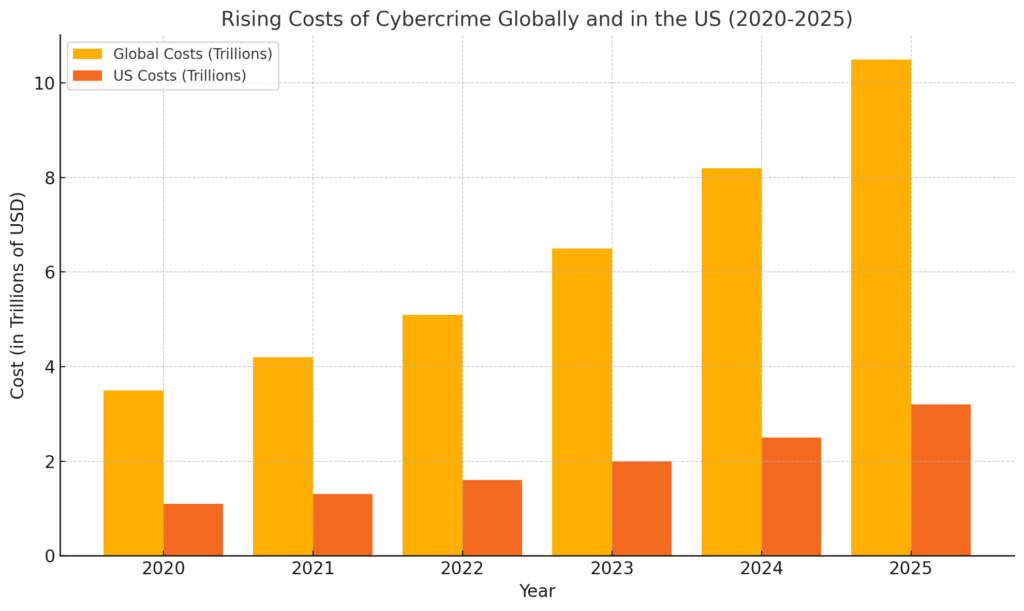Why Cybersecurity Is the #1 Priority for American Businesses in 2025 is a topic that has taken center stage in the news and business strategies alike. As cyberattacks grow in sophistication and frequency, businesses across the United States are grappling with how to safeguard their digital ecosystems. Major headlines in recent years have been dominated by ransomware assaults crippling essential services, data breaches leaking sensitive customer information, and phishing schemes targeting companies of all sizes. These real-world incidents underline the urgent need for prioritizing cybersecurity in 2025.
With cybercrime damages expected to reach $10.5 trillion annually this year, organizations can no longer afford to treat cybersecurity as an afterthought. Instead, it has become a foundational pillar for business continuity, customer trust, and regulatory compliance. This blog will delve into why cybersecurity is no longer optional but essential for every American business in 2025, exploring the challenges, strategies, and future trends that make it the #1 priority today.
Table of Contents
The Rising Threat Landscape
Cybercrime has surged dramatically over the past decade. According to a report by Cybersecurity Ventures, global cybercrime damages are projected to reach $10.5 trillion annually by 2025. These alarming statistics underline why cybersecurity must be at the forefront of business strategies. Ransomware attacks, phishing scams, and sophisticated hacking techniques have become more prevalent, targeting organizations of all sizes.

Data Breaches Are Costly
The financial impact of a data breach is staggering. The IBM Cost of a Data Breach Report 2024 revealed that the average cost of a data breach in the United States was $9.48 million. This figure includes lost business, legal expenses, and damage to brand reputation. For small and medium-sized enterprises (SMEs), such breaches can be catastrophic, often leading to permanent closure.
Growing Regulatory Pressure
Governments worldwide, including the United States, are implementing stricter regulations to ensure data protection. Compliance with laws like the General Data Protection Regulation (GDPR) and California Consumer Privacy Act (CCPA) is mandatory. Businesses failing to comply face hefty fines and legal consequences, making cybersecurity an essential investment rather than an optional expense.
Key Reasons Cybersecurity Tops the Priority List
Remote Work and Cloud Dependence
The COVID-19 pandemic has transformed work environments. With remote work becoming the norm, businesses rely heavily on cloud-based services and digital platforms. This shift has expanded the attack surface, making organizations more vulnerable to cyberattacks. Robust cybersecurity measures are vital to protect sensitive information shared over remote networks.
Evolving Cyber Threats
Hackers are continually devising new ways to exploit vulnerabilities. In 2025, businesses face challenges such as:
- AI-Powered Cyberattacks: Advanced AI tools enable cybercriminals to launch more targeted and efficient attacks.
- IoT Vulnerabilities: The proliferation of Internet of Things (IoT) devices has created additional entry points for hackers.
- Supply Chain Attacks: Breaches in third-party vendors can compromise an entire organization.
Customer Trust and Loyalty
Consumers are increasingly concerned about how businesses handle their personal information. A single data breach can erode customer trust, leading to loss of business. Prioritizing cybersecurity demonstrates a commitment to protecting customers’ data, fostering long-term loyalty and competitive advantage.
Implementing Effective Cybersecurity Strategies
Employee Training
Human error is one of the leading causes of cyber incidents. Training employees to recognize phishing emails, use strong passwords, and follow best practices can significantly reduce risks.
Advanced Threat Detection Systems
Businesses need to invest in cutting-edge technologies like artificial intelligence and machine learning to detect and respond to threats in real-time. Tools like Endpoint Detection and Response (EDR) and Security Information and Event Management (SIEM) systems are essential.
Zero Trust Architecture
Adopting a Zero Trust model ensures that every user, device, and application is verified before granting access. This approach minimizes potential vulnerabilities within a network.
Regular Security Audits
Conducting periodic security audits helps identify weaknesses and implement corrective measures promptly. Penetration testing and vulnerability assessments are crucial components of this process.
The Role of Leadership in Cybersecurity
C-Suite Involvement
Business leaders play a pivotal role in prioritizing cybersecurity. CEOs and CFOs must allocate sufficient budgets for cybersecurity initiatives and ensure alignment with overall business objectives. Engaging Chief Information Security Officers (CISOs) in decision-making processes is equally important.
Collaboration with IT Teams
Leaders must foster collaboration between IT departments and other business units. This ensures that cybersecurity measures are integrated into all aspects of the organization, from operations to customer service.
The Future of Cybersecurity
Emerging Technologies
As cyber threats evolve, so do cybersecurity technologies. Innovations such as quantum encryption, blockchain-based security, and advanced AI-driven solutions are expected to reshape the industry. Businesses that embrace these advancements will be better equipped to navigate the challenges of 2025.
Industry-Specific Solutions
Different industries face unique cybersecurity challenges. For instance:
- Healthcare: Protecting sensitive patient information under HIPAA regulations.
- Finance: Ensuring compliance with PCI DSS and safeguarding financial transactions.
- Retail: Securing e-commerce platforms against payment fraud.
Custom-tailored solutions will be critical for addressing these sector-specific needs.
Conclusion
Cybersecurity stands as the #1 priority for American businesses in 2025, driven by the escalating threats of cybercrime, which is predicted to cause damages of $10.5 trillion annually by the end of this year. Organizations that fail to act face immense risks, including financial losses averaging $9.48 million per breach and severe reputational harm. Furthermore, with regulatory pressures increasing and customer trust becoming a key differentiator, businesses must adopt robust cybersecurity measures to stay competitive.
Understanding “Why Cybersecurity Is the #1 Priority for American Businesses in 2025” is essential for companies aiming to thrive in today’s digital economy. By integrating advanced technologies, training employees, and prioritizing cybersecurity at the leadership level, businesses can protect their assets, comply with regulations, and foster long-term customer loyalty. The future of American enterprise hinges on proactive cybersecurity strategies that can meet the evolving challenges of a dynamic threat landscape. [TechGeniuxio.com]